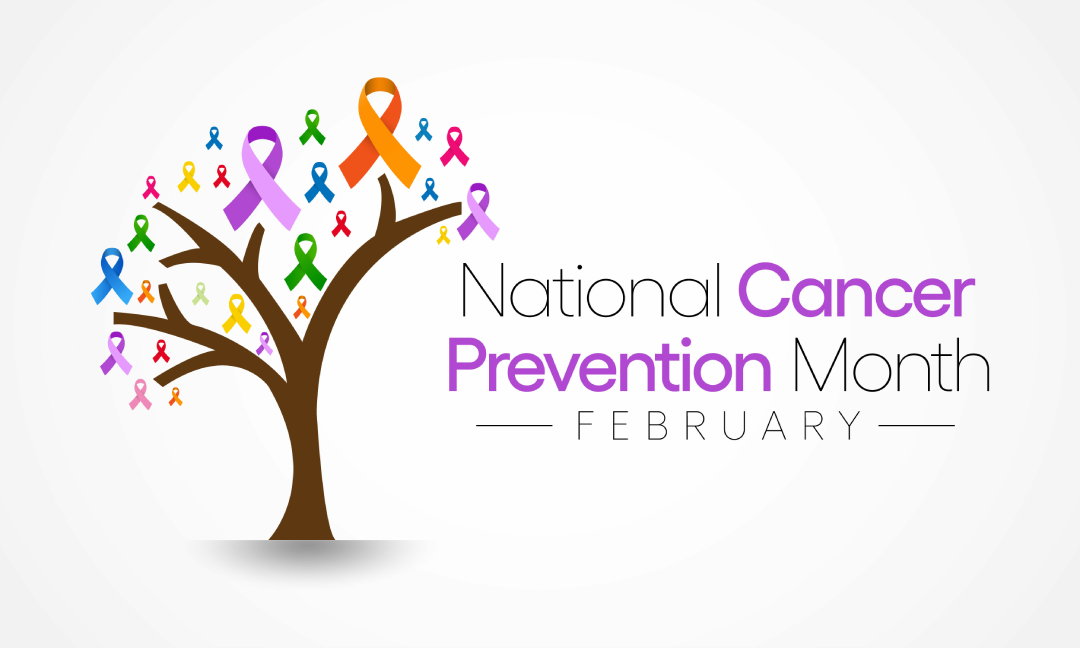Cancer remains a formidable adversary, touching countless lives across the globe. While advancements in treatment have been significant, the power of prevention cannot be overstated.
Did you know that more than 40% of cancer cases and nearly half of cancer-related deaths are linked to preventable causes? Factors such as smoking, excess body weight, physical inactivity, and excessive sun exposure play pivotal roles in cancer development.
By addressing these modifiable risk factors, we can take proactive steps toward reducing our cancer risk. February is recognized as National Cancer Prevention Month, a time dedicated to raising awareness about cancer prevention tips and encouraging individuals to adopt healthier lifestyles.
This observance serves as a reminder that through informed choices and proactive measures, we can significantly lower our risk of developing cancer. By embracing the insights and recommendations highlighted during this month, you can take meaningful steps toward safeguarding your health.
Understanding National Cancer Prevention Month
National Cancer Prevention Month is an initiative aimed at educating the public about the importance of cancer prevention. Spearheaded by organizations like the American Association for Cancer Research (AACR), this month-long campaign emphasizes the role of healthy lifestyle choices in cancer risk reduction.
By disseminating evidence-based information, the initiative empowers individuals to make informed decisions that can lead to healthier lives.
Strategies to Lower Your Cancer Risk
Reducing your cancer risk involves proactive lifestyle choices and consistent health monitoring. While genetics play a role, research shows that modifiable factors such as diet, exercise, and environmental exposure significantly influence cancer development.
By incorporating the following strategies into your daily routine, you can take control of your health and lower your chances of developing cancer:
1. Eliminate Tobacco Use: The Most Crucial Step
Tobacco use remains the leading cause of preventable cancer deaths worldwide. Smoking is directly linked to cancers of the lungs, throat, mouth, pancreas, kidneys, bladder, and cervix, among others.
Even secondhand smoke exposure increases cancer risk, making it essential to avoid smoke-filled environments. If quitting smoking feels overwhelming, resources such as nicotine replacement therapy, counseling, and behavioral support programs can help.
The benefits of quitting begin immediately—within hours, oxygen levels in the blood improve, and over time, the body begins to repair itself, significantly reducing the risk of cancer and other diseases.
2. Maintain a Healthy Weight: A Key to Cancer Prevention
Being overweight or obese is linked to a higher risk of developing breast, colon, endometrial, esophageal, kidney, and pancreatic cancers. Excess body fat causes chronic inflammation, alters hormone levels, and contributes to insulin resistance, all of which can trigger cancer growth.
The goal is not crash dieting but rather achieving and maintaining a stable, healthy weight through:
- Balanced nutrition that includes whole foods, fiber, and lean proteins.
- Portion control to prevent overeating.
- Regular physical activity to support metabolism and reduce inflammation.
Even a small weight loss—as little as 5 to 10% of body weight—can significantly lower cancer risk and improve overall health.
3. Engage in Regular Physical Activity: Move More, Live Longer
Exercise is more than just a fitness goal—it is a powerful tool for cancer prevention. Being physically active regulates hormones, boosts the immune system, and improves digestion, reducing the risk of breast, colon, and endometrial cancers.
Aim for at least 150 minutes of moderate exercise or 75 minutes of vigorous exercise per week. Simple lifestyle changes, like:
- Taking the stairs instead of the elevator.
- Walking instead of driving for short distances.
- Engaging in strength training twice a week for muscle maintenance.
Regular movement reduces inflammation, supports detoxification, and helps maintain a healthy weight, all of which contribute to cancer prevention.
4. Adopt a Healthy Diet: Food as Medicine
The foods we consume play a critical role in our health and longevity. A cancer-preventive diet should be rich in nutrients, antioxidants, and fiber to protect cells from damage.
Key dietary recommendations include:
- Eating a variety of fruits and vegetables—loaded with vitamins, minerals, and antioxidants.
- Choosing whole grains over refined carbohydrates to help regulate blood sugar and reduce inflammation.
- Limiting processed meats and red meats, which have been linked to colorectal cancer.
- Incorporating healthy fats like omega-3s found in fish, nuts, and seeds to combat inflammation.
- Reducing sugar intake, which can contribute to obesity and metabolic imbalances that increase cancer risk.
A simple rule to follow is: the more colorful your plate, the better for your health.

5. Limit Alcohol Consumption: Reducing Cancer-Related Risks
Alcohol consumption is a known carcinogen, meaning it directly contributes to DNA damage and cancer development. Excessive alcohol intake is linked to oral, esophageal, liver, breast, and colorectal cancers.
If you drink alcohol, moderation is key:
- For women: No more than one drink per day.
- For men: No more than two drinks per day.
Cutting back on alcohol can lower inflammation, stabilize hormone levels, and reduce overall cancer risk.
6. Protect Your Skin from UV Exposure: Sun Safety Matters
Skin cancer is the most common cancer worldwide, yet it is one of the most preventable. UV exposure from the sun and indoor tanning beds significantly increases the risk of melanoma, basal cell carcinoma, and squamous cell carcinoma.
To protect your skin:
- Use broad-spectrum sunscreen (SPF 30 or higher) daily, even on cloudy days.
- Wear protective clothing, hats, and sunglasses when outdoors.
- Avoid tanning beds and prolonged sun exposure during peak hours (10 AM to 4 PM).
- Check your skin regularly for new or changing moles, freckles, or spots, and seek medical attention for abnormalities.
Early detection of skin changes can prevent minor conditions from turning into severe skin cancers.
7. Get Vaccinated Against Cancer-Causing Viruses
Certain viral infections are major contributors to cancer development. Vaccinations can protect against these infections, reducing cancer risk.
- Human Papillomavirus (HPV) Vaccine: Prevents infections that cause cervical, anal, and throat cancers.
- Hepatitis B Vaccine: Protects against chronic infections that can lead to liver cancer.
Both vaccines are recommended for children and young adults but can also benefit those who have not been previously vaccinated.
8. Participate in Regular Cancer Screenings: The Power of Early Detection
Screening tests are life-saving tools that detect cancer in its early, more treatable stages. Recommendations vary based on age, gender, and risk factors, but common cancer screenings include:
- Mammograms for breast cancer (starting at age 40 to 50).
- Pap smears and HPV tests for cervical cancer.
- Colonoscopy or stool-based tests for colorectal cancer (starting at age 45).
- Low-dose CT scans for lung cancer in high-risk individuals (such as smokers).
- Prostate-specific antigen (PSA) test for prostate cancer in men over 50.
Regular screenings increase the chances of early detection, which improves treatment outcomes.
9. Be Aware of Environmental Risk Factors
Exposure to harmful chemicals, pollutants, and radiation increases cancer risk. Common environmental carcinogens include:
- Asbestos (linked to lung cancer).
- Pesticides (potential links to various cancers).
- Radon exposure (a leading cause of lung cancer).
Minimizing exposure to toxins, using safe household products, and drinking filtered water can reduce these risks.
10. Stay Informed and Educated: Knowledge Is Power
Cancer research is constantly evolving, and staying informed about prevention strategies can empower individuals to make better health choices. Reliable sources include:
- The American Association for Cancer Research (AACR).
- The Centers for Disease Control and Prevention (CDC).
- The World Health Organization (WHO).
Educating yourself and sharing knowledge with family, friends, and your community can lead to a collective effort in cancer prevention.

A Proactive Approach to Cancer Prevention
Reducing cancer risk is not about making drastic changes overnight but rather building sustainable habits that contribute to long-term health. National Cancer Prevention Month is an opportunity to reflect on daily choices and implement positive changes.
At Mason Park Medical Clinic in Katy, TX, we prioritize preventive health and provide guidance on screenings, lifestyle modifications, and early detection strategies. Our team is here to support you in your wellness journey and help you make informed decisions about your health.
Making small, intentional changes today can have a lasting impact on your future health—because prevention is the strongest weapon against cancer.
Call us now to schedule your appointment today!




